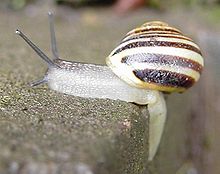
Helix is a genus of large, air-breathing land snails native to the western Palaearctic and characterized by a globular shell.
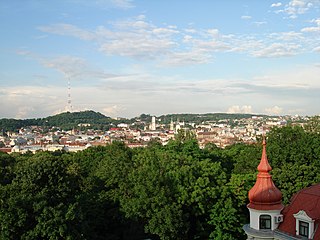
Lviv Oblast, also referred to as Lvivshchyna, is an oblast in western Ukraine. The capital of the oblast is the city of Lviv. The current population is 2,478,133.

The grove snail, brown-lipped snail or lemon snail is a species of air-breathing land snail, a terrestrial pulmonate gastropod mollusc.

Cornu aspersum, known by the common name garden snail, is a species of land snail in the family Helicidae, which includes some of the most familiar land snails. Of all terrestrial molluscs, this species may well be the most widely known. It was classified under the name Helix aspersa for over two centuries, but the prevailing classification now places it in the genus Cornu.

Heliciculture, commonly known as snail farming, is the process of raising edible land snails, primarily for human consumption or cosmetic use. The meat and snail eggs a.k.a. white caviar can be consumed as escargot and as a type of caviar, respectively.

Helicidae is a large, diverse family of western Palaearctic, medium to large-sized, air-breathing land snails, sometimes called the "typical snails." It includes some of the largest European land snails, several species are common in anthropogenic habitats, and some became invasive on other continents. A number of species in this family are valued as food items, including Cornu aspersum the brown or garden snail, and Helix pomatia. The biologies of these two species in particular have been thoroughly studied and documented.
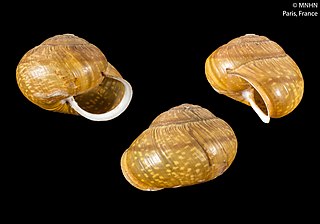
Arianta arbustorum, sometimes known as the copse snail, is a medium-sized species of pulmonate land snail in the family Helicidae.

Caucasotachea vindobonensis is a large species of air-breathing land snail, a terrestrial pulmonate gastropod in the family Helicidae.
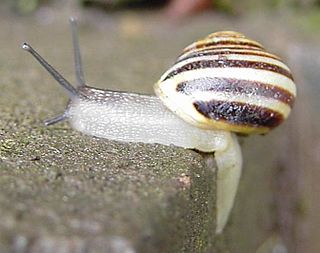
Cepaea is a genus of large air-breathing land snails, terrestrial pulmonate gastropod molluscs in the family Helicidae. The shells are often brightly coloured and patterned with brown stripes. The two species in this genus, C. nemoralis and C. hortensis, are widespread and common in Western and Central Europe and have been introduced to North America. Both have been influential model species for ongoing studies of genetics and natural selection. Like many Helicidae, these snails use love darts during mating.
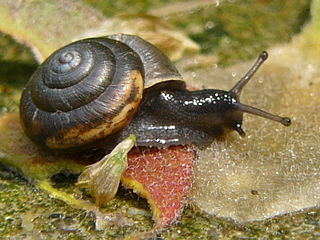
Hygromiidae is a taxonomic family of small to medium-sized air-breathing land snails, terrestrial pulmonate gastropod mollusks in the superfamily Helicoidea.

Theba pisana, common names the white garden snail, sand hill snail, white Italian snail, Mediterranean coastal snail, and simply just the Mediterranean snail, is an edible species of medium-sized, air-breathing land snail, a terrestrial pulmonate gastropod mollusk in the family Helicidae, the typical snails.

Carychium minimum is a species of very small air-breathing land snail, a terrestrial pulmonate gastropod mollusk in the family Ellobiidae.

Macularia sylvatica is a medium-sized species of air-breathing dextral land snail, a terrestrial pulmonate gastropod mollusc in the family Helicidae. It was once seen as a close relative of the grove snail, but does in fact not belong to the genus Cepaea at all.

Caucasotachea is a genus of medium-sized air-breathing land snails, terrestrial pulmonate gastropod molluscs in the family Helicidae.
Helicinae is a subfamily of terrestrial gastropods in the family Helicidae. It contains mostly large land snail species, distributed in the western Palaearctic. The most recent classification proposed division into three tribes.















